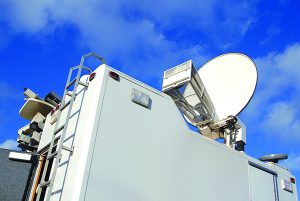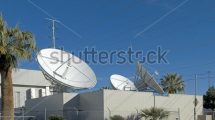 Large broadcasters, news agencies or broadcast unions are looking to automate workflows in order to reduce mainly OPEX in many ways. At the same time, automation on a converged IP network allows users to lay out workflows end to end on hybrid networks.
Large broadcasters, news agencies or broadcast unions are looking to automate workflows in order to reduce mainly OPEX in many ways. At the same time, automation on a converged IP network allows users to lay out workflows end to end on hybrid networks.
“As delivering content in new ways to multiple devices and in different formats is incredibly complex, and upgrading legacy networking systems can be a costly undertaking, media companies are also interested in purchasing a managed service from satellite service providers or satellite operators. This also provides the advantage of being able to access a network via the service provider or satellite operator. Another trend we see is the requirement for occasional use setup of IP trunks between truck and studio,” says Hans Massart, Market Director Broadcast at Newtec.
Ali Zarkesh, VP Product Management at Vislink agrees and adds that he sees a trend in the move towards smaller news vehicles that include bonded satellite and cellular transmission capabilities. He thinks the correct equipment, together with improved technology, offers the ability to combine both methods of data transport to achieve the necessary data rates to transmit HD video.
Roger Franklin, CEO of Crystal says: “The size of equipment will continue to decrease, while automation will increase, which will compensate for any potential human error and make the process of SNG more efficient, and greatly reduce errors, such as those that cause satellite interference.”
He sees the road ahead as being paved with major developments for antenna technology, alleviating the need for the news gathering team to point the antenna.
“We already see innovation from companies such as Kymeta, but we may see the same technology deployed on Low Earth Orbit satellites first, giving easy connectivity to just about anyone, anywhere in the world. Eventually all news gathering video will be transmitted in IP format and will travel the best path possible: terrestrial, GEO satellites, or LEO satellites,” comments Franklin.
SNG equipment is typically used in environments where traditional resources for video transmission are not available, such as microwave link, fibre, and IP-based backhaul. Or it can be used when the connection isn’t strong enough to transmit video over the cellular network.
A mobile uplink is deployed to a remote location as a means to transport video, audio or data via satellite to a downlink site. There are SNG trucks dedicated to networks to gather news and there are mobile uplink companies that lease their services for broadcast specific events.
Zarkesh says: “SNG is used to transmit video from a remote location. Typically, this is for live event coverage, such as a forest fire. However, it can also be used to distribute video to multiple networks for re-broadcast, such as a World Cup soccer game.
“SNG also has two-way voice and data capabilities, letting the user receive communications from the studio. This can offer an extension to the remote satellite, as if it was part of the existing LAN architecture,” adds Zarkesh.
Massart thinks there is a direct influence on the equipment used, ranging from the cheapest, most often terrestrial 3G/4G based Fast News Gathering (FNG) single contribution, to the highest quality, with UHDTV grade encoders and full chain redundancy under control of an automation system for, for example, F1 racing events.
Zarkesh explains that besides broadcasters, organisations focused on disaster recovery and military forces are avid users of SNG.
“For broadcasters, as they never know where a story will break, it’s important to have maximum flexibility in terms of transmission methods to ensure a story can be relayed live from the field to the newsroom. It’s for this reason satellite is the go-to solution for remote coverage, where the cellular network is unable to support video throughput.”
Expanding further on the role of SNG, Franklin explains that SNG is invaluable during natural disasters, particularly when the terrestrial network is unreliable. Another use of SNG can be during long-term news events, such as a criminal or civil trial where local connectivity is not easy to come by. Furthermore, SNG can also be used extensively during major events, such as the Olympics, where it can serve as a backup in case of terrestrial connectivity issues.
“In terms of equipment, every SNG truck needs a certain amount of basic equipment including a video encoder, quality control equipment, modulator, transmitting satellite encoder, and either an up converter and amplifier or transceiver. A video file server is often included, as is a receiver, enabling the reporters to watch their own uplink and ensure data connectivity back to headquarters.
“Some news trucks, such as CNN, have data modems on board, allowing them to extend the internal phone system to the SNG truck allowing directors to communicate with the truck as if they are in the studio next door,” says Franklin.
SNG equipment is continuously upgraded, with the aim of being more portable, easy to deploy and effective in various environments.
Massart says: “If 3G/4G networks are available they are probably more cost-effective. However, in remote areas, bandwidth/coverage may be unavailable for certain events, for example, if everybody starts using 3G/4G, overbooking will occur. In such cases, satellite is the only viable alternative.
“SNG trucks are downsizing to camera cars, due to further integration and miniaturization of products and components but also due to, for example, the advent of Ka-band. A journalist and cameraman plan are enough to handle the event coverage but for large events, which are well planned in advance, SNG vans may well be accompanied by OB vans to allow full production. Security reasons and even weather conditions will also make sure not all SNG vans will become camera cars.”
Meanwhile, the need for supporting both linear and non-linear, tapeless workflows has triggered a dramatic increase in the capabilities and subsequent complexity of a modern SNG broadcast network.
Challenges and Solutions
Operating these SNGs has become increasingly challenging. Flexible SNG transmission equipment is therefore key for successfully bringing breaking news to the studio.
“Newtec’s satellite broadcast modems deliver the complex features today’s broadcasters need, while also ensuring user-friendly and hassle-free operations. In this respect, Newtec’s broadcast modems support DSNG profiles, according to the WBU-ISOG working group. This set of pre-configurations will ease line-up, shorten time-to-deployment and limit transmission errors,” adds Massart.
Abdullah Battah, CTO of ABS Network, one of the largest broadcast services companies in the Middle East and North Africa, says that throughout the years, technology is allowing SNG equipment to become compact and portable.
“New technology of broadcast such as HD, MPEG-4, DVB-S2 has been added and created and today we see that more bands are created to enhance the performance and utilise the satellite bandwidth.
“In some countries, tackling regulations and permissions is a challenge. The equipment, as it is highly specialised, is expensive to purchase as well as to operate since it requires specially trained staff. This also means that sometimes SNG solutions require a long time to deploy. Due to the power consumption, it is always necessary to have an efficient high power electric power supply, and since the equipment is typically deployed in the field and is so specialised, it is unlikely that in the event of any failure, you would have spare parts available. Finally, to effectively transmit the signal to the satellite might require an open space and line of sight to be maintained which is not always easy to accomplish,” says Battah.
Other challenges involve condensing the size of the equipment and ensuring pointing accuracy of the antenna. If this is inaccurate, it is much more likely to cause problems such as adjacent satellite interference.
“Because the equipment is small and portable, it is easy for the “powers that be” to make an assumption that an engineer doesn’t need to go. This may work if the SNG is equipped with the right antenna pointing software, but if something goes wrong, the news gathering team may not know how to solve the problem. The cameraman and reporter may not understand that a stable platform and clear look angle are required during transmission. This leads to mistakes, such as pointing the antenna through power lines, or jostling or moving the antenna during transmission,” adds Franklin.
The good part is these challenges can easily be overcome by addressing personnel, equipment quality and technology through global initiatives.
Martin Coleman, Executive Director, IRG explains: “Often the people operating the SNG equipment are not engineers, and they do not fully understand the systems they are using. Our End Users Initiative Advisory Committee has established a specific SNG training course with the Global VSAT Forum (GVF), which aims to address that. If we can train the SNG operators, they will be able to maintain the equipment appropriately, ensure the right conditions and clear angle for transmission and troubleshoot any problems they may experience. The challenge is overcoming the assumption that SNG is just about pressing a few buttons to ensure that SNG operators are getting appropriately trained.
“Secondly, equipment quality, through GVF quality and type approval initiatives to ensure that all equipment meets global set of accepted requirements. Finally, using technology, which is a main focus for IRG through a variety of initiatives. The most common form of technology solutions for this type of system is auto-deployment and automatic scheduling of transmissions. This is where the user is purely there to monitor progress and concentrate on the content transmitted,” concludes Coleman.












Add Comment